
ADA, Inpulse and the Grameen Crédit Agricole Foundation have joined forces to monitor and analyze the effects of the Covid-19 crisis on their partner microfinance institutions around the world. This monitoring is done on a regular basis and will be carried out throughout 2020 in order to obtain better insights of developments. We hope this regular and in-depth analysis will contribute to building strategies and solutions adapted to the needs of our partners, and also to the dissemination and sharing of information among the various players in the industry.
In Summary
The results presented in this article are drawn from the fourth survey [1] in a joint series by ADA and the Grameen Credit Agricole Foundation, Inpulse having chosen to join the initiative one time out of two. Responses were collected between October 1st and October 20th from 73 microfinance institutions (MFIs) in 38 countries in Sub-Saharan Africa (SSA-37%), Latin America and the Caribbean (LAC-25%), Eastern Europe and Central Asia (ECA-18%), Asia (15%) and Middle East North Africa (MENA-4%) [2].
Given that previous surveys had revealed that the main financial difficulty for MFIs was the increase in their Portfolio at Risk (PAR), the new survey took a closer look at how MFI clients and their businesses were doing as this is what MFIs mainly depend on. Above all, the results of this survey confirm the gradual resumption of MFI activity, along with a reduction in most of the operational constraints initially encountered. The major remaining constraint has to do with loan recovery which explains the increase in PAR as the main financial difficulty for MFIs.
This difficulty in loan recovery may be due to external constraints, such as mobility or moratoria imposed by authorities, or to difficulties encountered by the clients themselves whose activities have not yet restarted or are slowed down by the impact of the crisis. Indeed, even if the peak of the health crisis has passed and it has affected to a lesser extent regions such as sub-Saharan Africa or South-East Asia, thus allowing a number of business sectors to restart, it is all too soon to expect a return to normal. Especially, the restrictive measures and the overall economic situation have negatively impacted — and still do — activities in a certain number of industries, thus restricting the sources of income of the populations. Consequently, this affects MFIs and their financial situation which is why it seems crucial to monitor closely how the crisis is experienced by their clients in order to be responsive in adapting to their needs by offering solutions allowing everyone — clients and MFIs alike — to survive this crisis.
1. THE RECOVERY OF MFIS IS STILL CONSTRAINED BY THE DIFFICULTY IN COLLECTING LOANS
The responses collected during the month of October show that most MFIs are gradually resuming their activities (Fig. 1). Only those of some MFIs in Myanmar remain very limited by the constraints represented by containment measures currently in place in the country, as are the activities of a minority of MFIs in sub-Saharan Africa (one MFI in Mali and one in Malawi). In Europe and Central Asia, the share of MFIs having achieved their normal activity level is most significant.
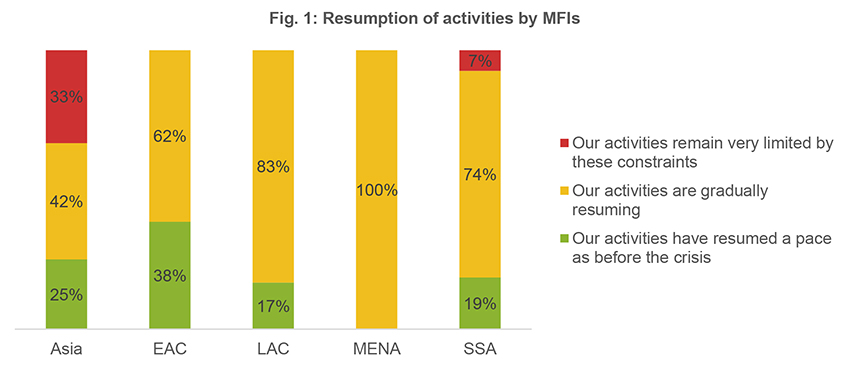
One of the constraints being encountered by MFIs that previous surveys have revealed was that part of their staff and client base were affected by Covid-19. Hence, we focused on the prevalence of the Covid-19 disease among staff and clients. Fig. 2 and 3).
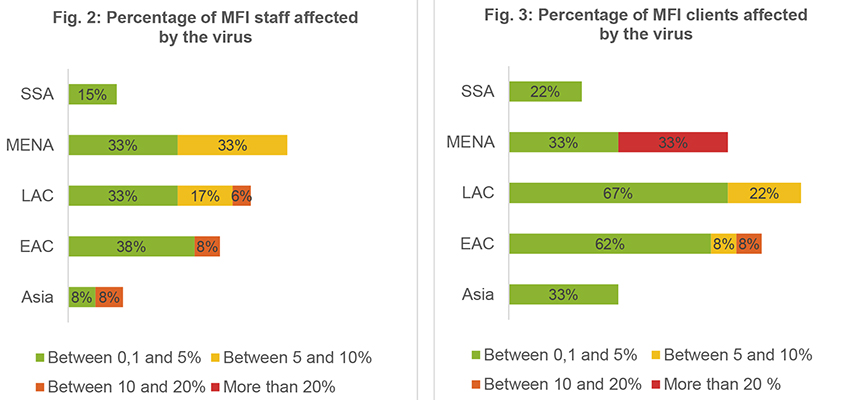
The situation is mixed in this respect: The Sub-Saharan Africa region appears as the least affected with just a small proportion of MFIs reporting that their staff (15%) or their clients (22%) are affected. Moreover, this proportion remains very small (between 0.1 and 5%) with 70% of the region’s MFIs reporting that neither their clients nor their staff have been affected by the virus. On the other hand, the Latin America and the Caribbean region is the most affected, followed by Europe and Central Asia with a larger share of MFIs concerned by the virus (just 11% of MFIs in the LAC region reporting that neither their staff or clients were affected), and it shows a larger prevalence rate for some of those MFIs [3]. Nevertheless, even if the health situation is more problematic in those regions, it still remains for the time being a relatively minor constraint for MFIs.
Moreover, on a global scale a relatively important proportion of MFIs report that they do not encounter any constraints. (Fig.4), mainly in the Europe and Central Asia regions (62%), while those facing some constraints are fewer with every survey, thus showing a gradual recovery.
The major remaining constraint (32% of MFIs in the sample) is about the difficulty in collecting loan repayments. This implies an increase in the portfolio at risk which is the main financial difficulty encountered by MFIs everywhere. It is reported as such by 77% of MFIs while other difficulties show a diminishing pattern in every survey.
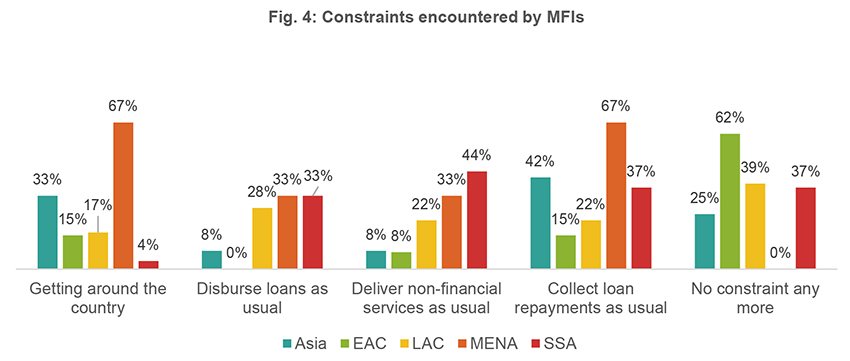
This difficulty or impossibility of collecting loan repayments can be explained by mobility constraints, mainly in countries or internal regions where containment measures are still in place, but also by the implementation of moratoriums – be they initiated by authorities or by the MFIs themselves if the clients needed them. Indeed, these moratoriums concerned the majority (84%) of MFIs surveyed in the sample (Fig. 5), and they are still in place for almost a half of MFI clients (48%) in total. Asia is the region where this situation is more frequent (83% of MFIs included in the sample).
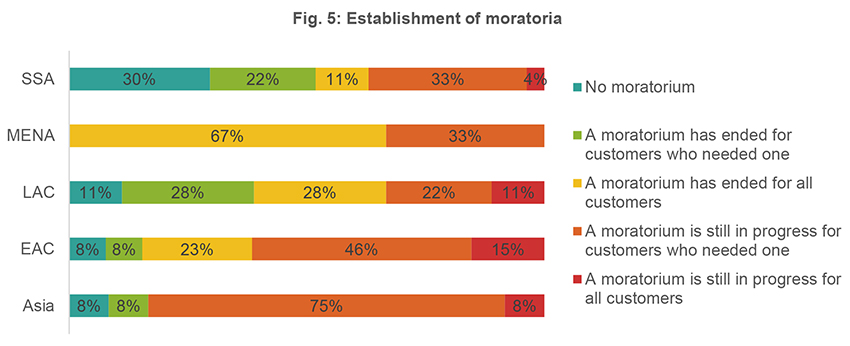
Among clients having benefited from a moratorium, those repaying normally their loans once it ended are a minority (Fig. 6). The majority of MFIs (86% of the sample) report that some or all of the clients needed a new moratorium, or even ended up in the portfolio at risk with 39% of MFIs in the sample affected by the latter situation. In Europe and Central Asia, and in Sub-Saharan Africa, more than half of MFIs report a move to their portfolio at risk of part of their clients having benefited from moratoria.
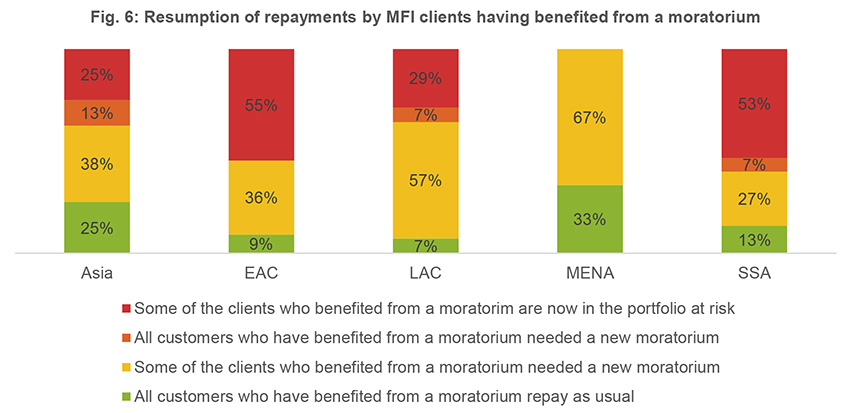
Nevertheless, globally speaking, the majority of MFIs in every region report that at least 70% of clients repay their loans. (Fig. 7). In South and Central Asia and Europe, more than 80% of respondents show repayment levels above 70%. On the other hand, the situation is not as good in Latin America and Caribbean and Sub-Saharan Africa regions: 34% and 45% of MFIs respectively with less than 70% of clients repaying their loans, and 17% and 15% where this proportion is less than 50%.
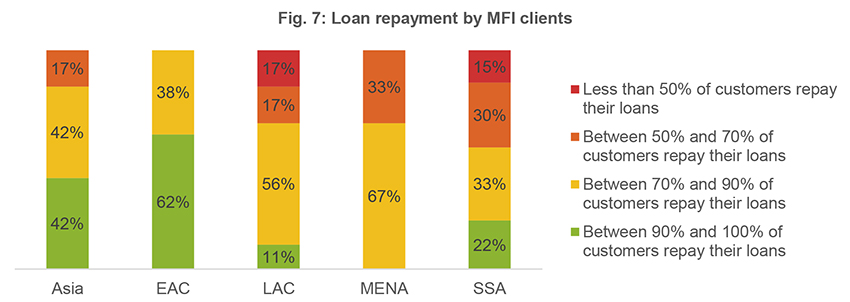
2. THE RECOVERY OF MFI CLIENTS IS FACING CONSTRAINTS
These repayment levels, being both volatile and lower than the pre-crisis normal, can be explained partially by the fact that not all customers are still able to resume their activities: Once again, excepting the Europe and Central Asia regions, only a minority of MFIs report that 90% or more of their clients have resumed their activity. However, for a majority of MFIs in the sample (54% in total), between 50 and 90% of clients have resumed their activity. The overall trend therefore points towards gradual recovery.
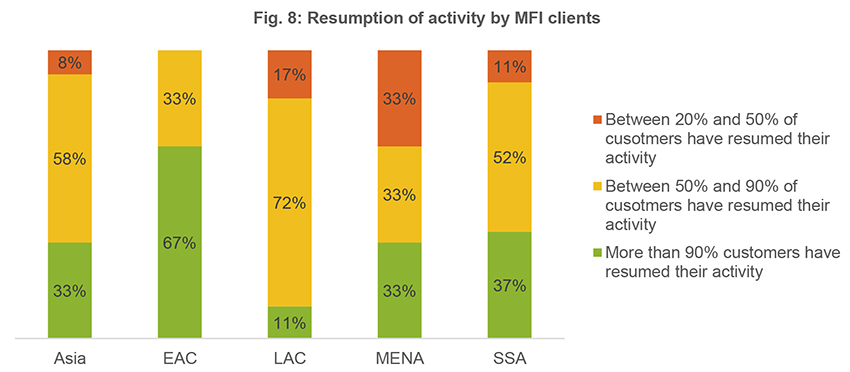
However, even if customers do resume their activities, some sectors are more affected by the crisis than others. The business activity most often mentioned as being most affected is tourism in regions other than sub-Saharan Africa, where it is retail (reported by 48% of MFIs in the region). The services sector is second in most regions except in Asia where the production and crafts sector is more affected. On the other hand, agriculture is reported only once. Overall, the agriculture sector appears to have been less affected than others by the Covid-19 crisis, as our previous work already showed, where a number of MFIs stated that they wanted to focus more on agriculture as it was less affected by the crisis.
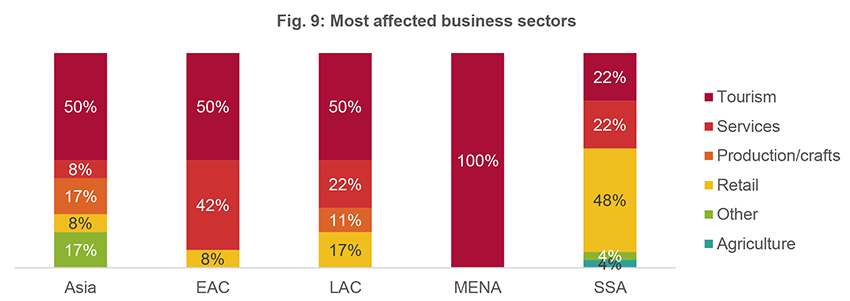
When looking at the constraints faced by customers, by sector, it appears that these constraints are specific to each of them (Fig. 10). Regarding the tourism industry, it is the decrease in the number of clients of entrepreneurs working in it that is the main source of difficulty, followed closely by the loss of employment, mentioned by 60% of MFIs who identified tourism as the most affected sector. On the other hand, in other sectors, the loss of jobs by clients does not appear to be among the main constraints identified. The decrease in the number of customers remains one of the major constraints, for the retail sector as well as for services or production and crafts. The same result is found in other surveys directly targeting MFI customers, such as those using the tool developed by SPTF where the reduction in demand is identified as the main reason for the decline in revenues [4]. Finally, the lack of business opportunities is the first constraint for the retail sector (reported by 72% of MFIs identifying this sector as being the most affected), while the difficulty in producing or offering products is typical of the production and crafts sector.
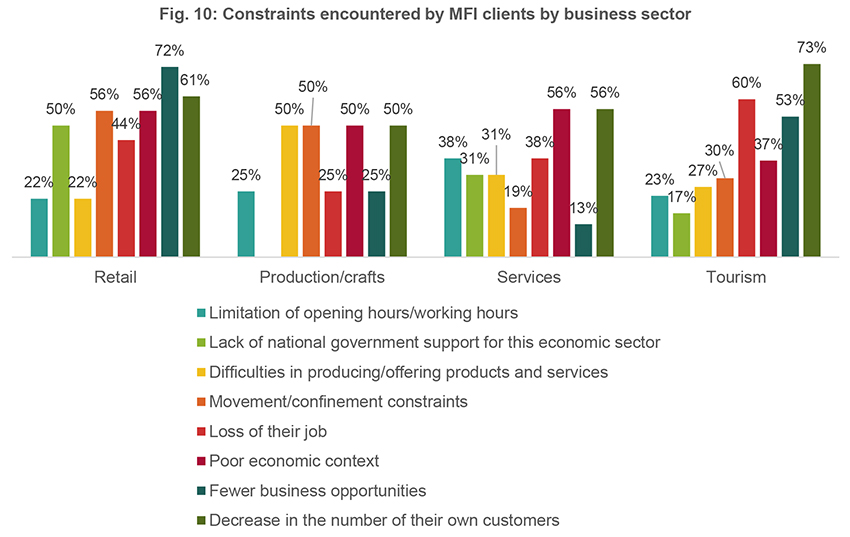
By focusing on the specific constraints faced by their clients depending on their industry, but probably too on other factors, MFIs would thus be able to better anticipate their financial situation in the short term, and respond appropriately to the needs of their different customer segments: This would allow them all to better navigate this crisis. This responsiveness seems to have already been adopted by some MFIs, given that, and beyond the priority given to the repayment of credits or their restructuring, some of them have introduced not only new channels of digital communication and distribution, but also new credit policies or new products (Fig. 11).
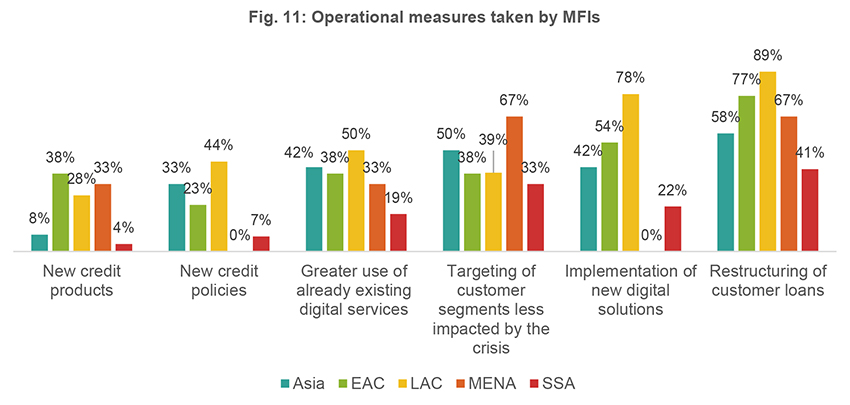
___________________________________________________________